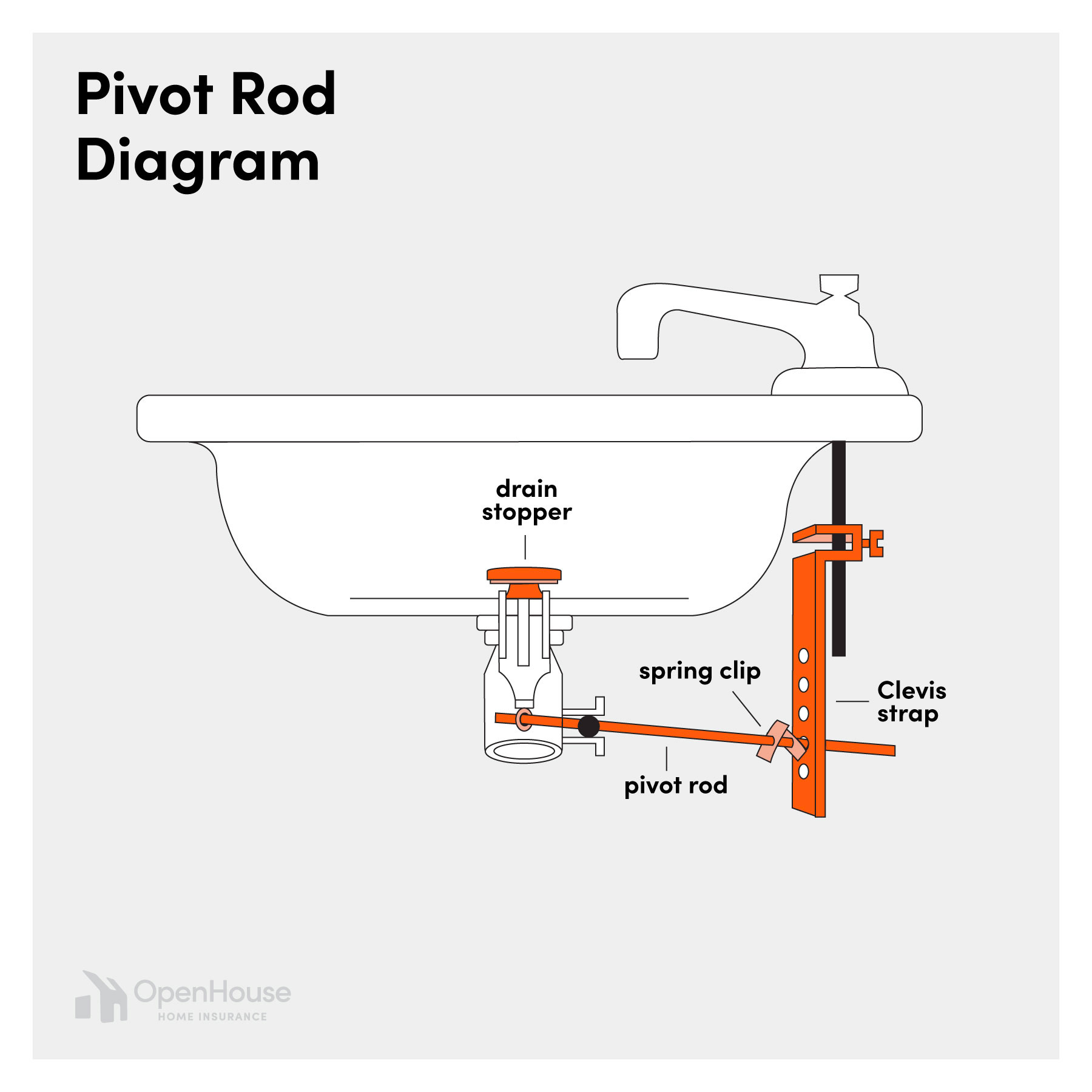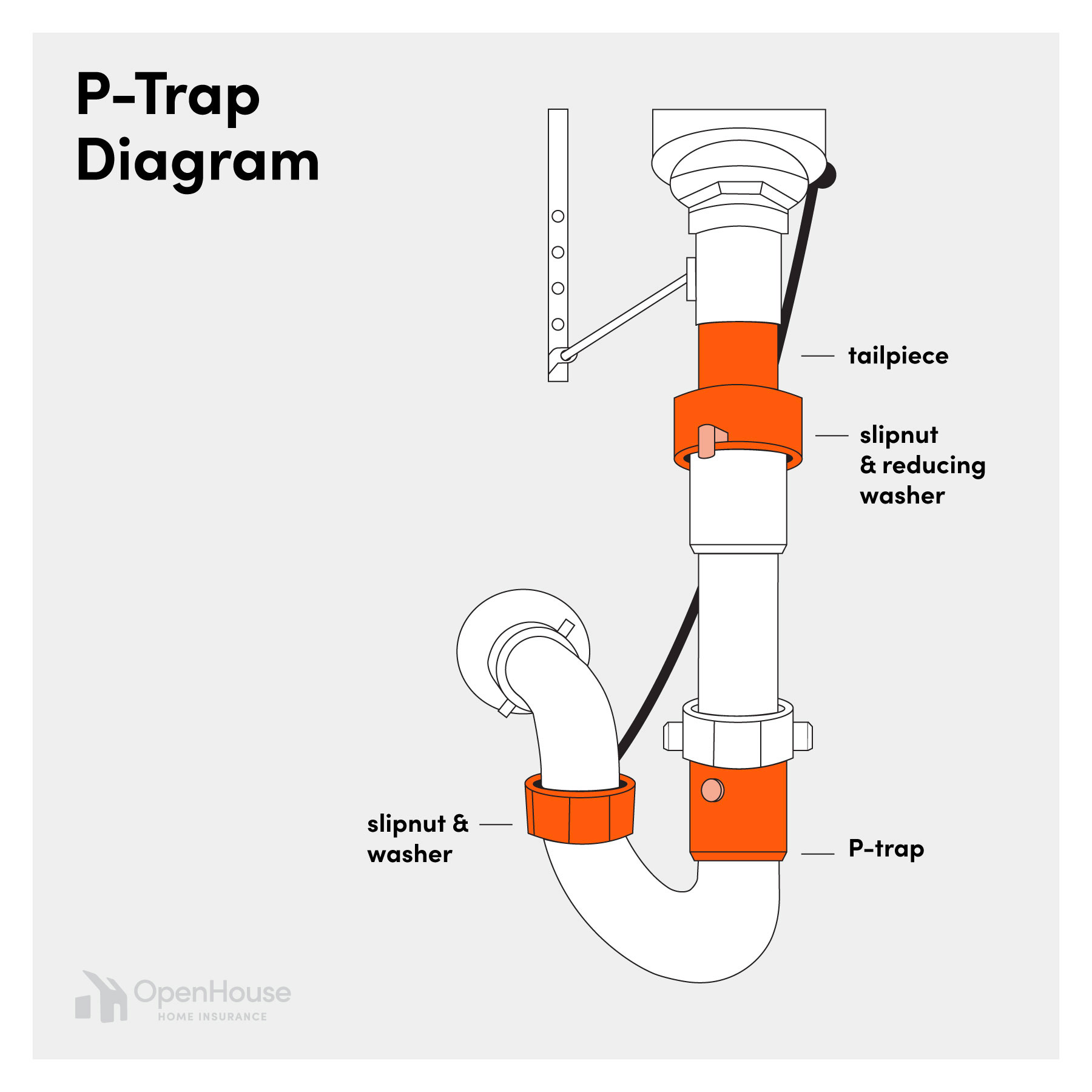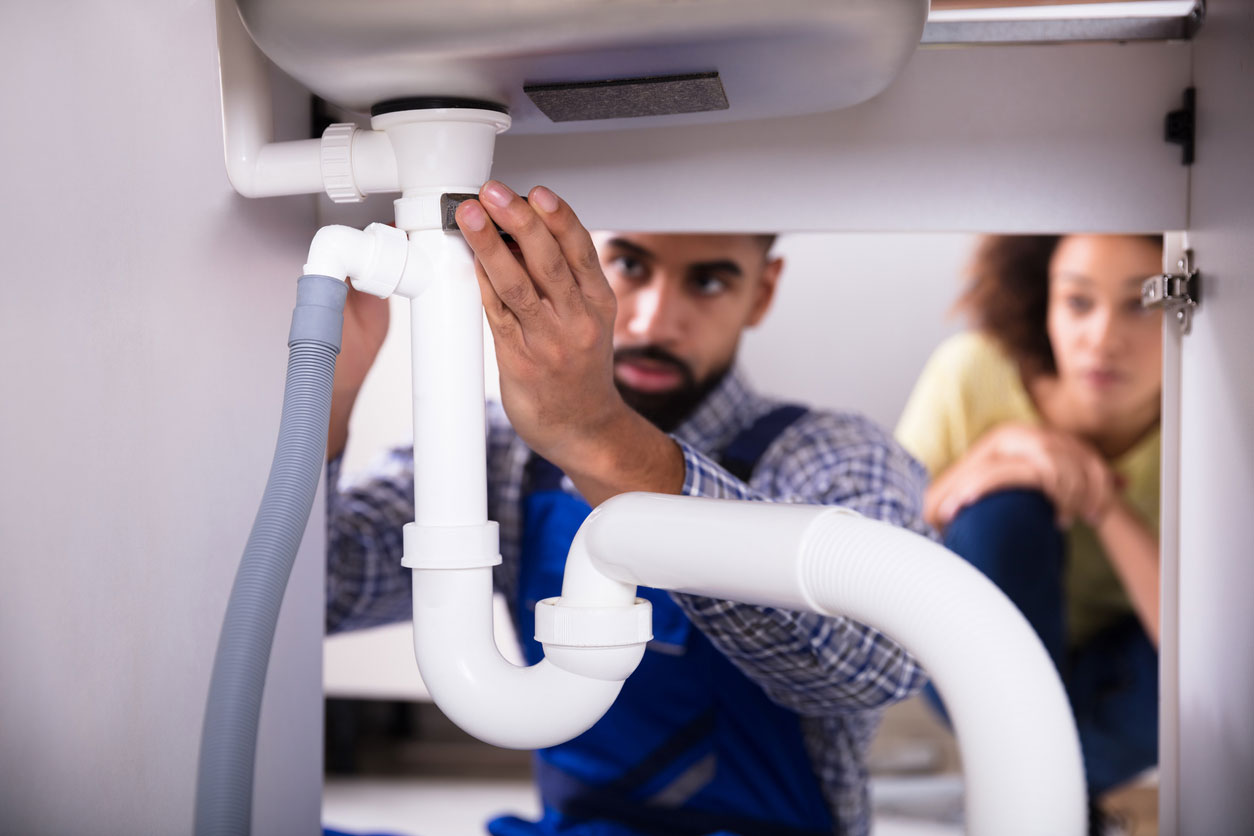A slow-draining or clogged sink can throw everything out of, well, sync. Routine grooming becomes frustrating with a backed-up drain that smells bad and leaves you waiting for the dirty water to go down.
If your sink drains slowly, clear the debris in your pipes before it gets to a full clog to avoid damage to your pipes—and prolonged inconvenience.
Understanding what caused the clog in the first place can help prevent future clogged bathroom sinks by monitoring what goes inside your drain.
Why Is My Bathroom Sink So Clogged?
If your bathroom sink won’t drain, there are a few possible culprits. But assuming you don’t have a damaged pipe, a backed-up drain is most likely a combination of the first three listed below.
- Hair: Small hairs from shaving, long strands from your head, and everything in between can tangle and build up in the drain.
- Soap scum: The fatty acids in soap react with minerals that may be present in your water, causing soap scum that builds up in the drain.
- Solid debris: Pieces of food after flossing, dirt, toilet paper (which should never go down your sink drain), and anything else solid can get trapped in hair and build up, worsening the clog in your drain.
- Toothpaste and other products: Toothpaste and grooming products, like hair gel and makeup, can build up in the drain.
- Clog further down the line: Sometimes, damage to pipes or something stuck further down in the sewer line leads to multiple backups in your home, including your bathroom sink. These types of clogs require a professional plumber to fix.
What Drain-Cleaning Methods Are Bad for Pipes?
Boiling Water in PVC Pipes
Some of the methods we share below involve pouring hot or boiling water down the drain to unclog a bathroom sink.
If you have plastic PVC pipes, washing boiling water down your bathroom sink when you have a clog can cause the hot water to sit above the clog and potentially soften or melt the pipes. If you have a porcelain sink, boiling water can also crack the sink.
That said, boiling water is generally acceptable when trying to unclog metal pipes.
Coca-Cola
Interestingly, some people successfully clear some drains with sodas like Coca-Cola and Pepsi because of their phosphoric acid, but you risk worsening the problem later.
While these drinks can clear gunk in your drains, the syrup that makes these sodas sweet leaves behind a sticky coating on your pipes, causing debris to build up again.
Plus, sugar in your drain is a good way to attract flies, roaches, and other pests.
Chemical Drain Cleaners
Chemical drain cleaners like Drano are caustic, meaning they use corrosive chemicals that break down organic matter and some metals. They can cause skin irritation and are dangerous to use around kids and pets.
While they effectively break through clogs, the chemical cleaner will sit on the blockage and heat up as it reacts with the substances. If you use chemical cleaners often, this reaction can soften or melt PVC pipes and damage metal pipes.
Using chemical drain cleaners can also harm the environment if it reaches plants and animals from the sewer.
Baking Soda and Vinegar Mixture
If you’re wondering how to unclog a bathroom sink with baking soda and vinegar, it’s best to save this mixture for cleaning in other areas of the house—not the drain.
The bubbling reaction caused by mixing baking soda and vinegar can break up clogs in drains, but while this mixture is effective and safe for your health, it is highly acidic and can break down rubber and plastic in your pipes.
A note on environmentally safe drain cleaners
There are drain cleaners, like Green Gobbler Drain Clog Dissolver, that don’t use caustic chemicals like sodium hydroxide or bleach and may not cause damage to your pipes. However, these drain cleaners are still corrosive and can cause skin irritation. The best way to unclog a bathroom sink is to use one of the methods we outline below to unclog your sink naturally.
6 Natural Ways to Unclog a Bathroom Sink Drain
There are several natural ways to unclog a drain using household products. Some of these methods also apply to kitchen sinks and shower drains.
Try each of these methods to fix a slow-draining sink safely. If the first method doesn’t work, try the next.
A note on drain stoppers with a pivot rod
Some of these methods for unclogging your bathroom sink require removing your drain stopper if your sink has one. Some drain stoppers may have a metal rod, called a pivot rod, holding them in place.
Using the diagram below as a reference, release the pivot rod by first unscrewing the pivot rod nut or undoing the spring clip. Then, slide the pivot rod away from the drain stopper. After you do this, you can remove the drain stopper from the sink.
If you don’t feel comfortable removing the pivot rod yourself or trying the methods below, call a plumber to help.

Boiling Water to Unclog a Bathroom Sink
Boiling water only works for a slow-draining bathroom sink. If you have a fully clogged sink where water doesn’t drain, skip to the plunger method below.
You can also use this method on all drains in your house. Remember that boiling water can damage porcelain sinks and clogged PVC pipes.
What you need:
- Kettle or pot
- Rubber gloves
Steps:
- If you have a slow-draining sink, let any standing water in the sink drain completely. Depending on how much water is in the sink, this may take a while.
- Fill half a kettle or pot with water and bring it to a rolling boil on your stove.
- Remove the drain stopper if your sink has one.
- Wearing rubber gloves to protect your hands from possible splashing, then slowly pour some of the boiling water down the drain, but not all of it. If this method works, it should unclog your drain almost immediately.
- If the first pour doesn’t work, repeat until the sink clears.
- Run hot water from the faucet to clear any residue in the drain.
If this method isn’t working, continue to the next method.
A Plunger to Unclog a Bathroom Sink
When boiling water can’t break up a particularly dense clog, turn to a plunger. Make sure to use a cup plunger, which has a broad opening at the end and is meant for sinks, versus a flange plunger, which has a smaller cup at the end and is meant for toilets.
If your sink is full of standing water and isn’t draining at all, use a cup to scoop as much water out as possible before you try plunging.
What you need:
- Cup plunger
- Packing tape or rag
Steps:
- Remove your drain stopper.
- Turn on the faucet to cover your drain with about an inch of warm water, but no more.
- Cover the seal overflow outlet (the little hole opposite your faucet in the sink) with tape or a rag to prevent any pressurized buildup from coming out.
- Apply the plunger flush with the drain and apply force downward to create a vacuum with the water.
- Pump the plunger with sharp up-and-down movements for about 15 seconds. Remove the plunger.
- You may see the buildup clogging the drain come up into the sink. After cleaning the buildup, check to see if the water has cleared.
- If the water has not cleared, repeat the steps a few more times.
If this method isn’t working, continue to the next method.
A Drain-Cleaning Tool to Unclog a Bathroom Sink
When breaking down, plunging, or vacuuming a clog isn’t possible, it’s time to extract it directly using a drain-cleaning tool or a wire coat hanger that you unbend into a long wire with a hook.
You can also use this method on all drains in your house.
What you need:
- Drain-cleaning tool like Zip-It or wire coat hanger
- Rubber gloves
Steps:
- Feed the drain-cleaning tool or wire hanger hook-side down into the drain, either with the drain stopper on or off.
- Move it side to side. The teeth on the plastic strip or the hook on the hanger will catch any hair and gunk.
- Pull the tool or hanger out of the drain and remove any debris with rubber gloves.
- Repeat until there is no more debris.
If this method isn’t working, continue to the next method.
A Drain Snake to Unclog a Bathroom Sink
Similarly to using a drain-cleaning tool or wire hanger, you can employ a drain snake, also called a drain auger, to get the unclogging job done.
A drain snake uses a hand crank and a long metal wire with a broader coiled head at the end to snag clogs from pipes and pull them up to the surface.
You can also use this method on all drains in your house.
What you need:
- Drain snake/drain auger
- Rubber gloves
Steps:
- Remove the drain stopper.
- While different brands of drain snakes may vary, all require you to hand-feed the wire down the drain until you hit the clog.
- Rotate the crank clockwise until the wire completely comes out of the drain.
- Repeat if necessary.
If this method isn’t working, continue to the next method.
A Wet and Dry Vacuum to Unclog a Bathroom Sink
A wet and dry vacuum is a machine with a hose that you use to suck up liquids and solids. Below, we tell you how to prepare the pipes beneath your sink so you can use a wet and dry vacuum to dislodge any buildup causing the clog.
Before you do that, you need to understand what a P-trap is. A P-trap is the curved pipe under most sinks.
Together with the vertical pipe that connects to the sink basin, they form a letter ‘P’ shape, hence the P-trap’s name. Its function is to trap water using gravity and block poisonous sewer gases from entering the home.

The P-trap can sometimes clog beyond what the previous methods can remedy, so you need to dissemble it before using the wet and dry vacuum. If you’re not comfortable dissembling the P-trap yourself, call a plumber.
What you need:
- Wet and dry vacuum
- Screwdriver or wrench
- Rag (if you don’t have a drain stopper)
- Bucket
Steps:
- Make room under your sink to place a bucket under the P-trap. The bucket will catch any trapped water that may spill.
- Depending on whether screws or slip nuts hold together your P-trap, use a screwdriver or wrench, respectively, to detach the curved pipe from the vertical pipe.
- Switch your wet and dry vacuum to the “wet” or “liquid” setting.
- Attach the wet and dry vacuum hose to the vertical pipe under the sink.
- Cover your drain with the drain stopper or a rag.
- Switch the wet and dry vacuum on. You can switch it on and off a few times to create momentum for the clog to dislodge. You may hear the clog enter the vacuum or peek out the pipe’s end, which you can remove manually.
- Reattach the P-trap and test the sink.
If this method isn’t working, it’s time to call a plumber.
Call a Plumber to Unclog a Bathroom Sink
We know removing that pesky blockage in your sink is satisfying to do on your own.
But if your bathroom sink clog is proving to be more difficult than you have time for, or if your bathroom sink keeps clogging, call a local plumber to solve the problem.
And if you have a bathroom sink clogged behind the wall with pipes out of reach, call a plumber. Professional plumbers have the expertise to deal with all things related to your pipes, and they may be able to identify problems in the sewer line that go way beyond your P-trap.
How to Prevent a Bathroom Sink Clog
While you likely came to this article searching for ways to remove an existing clog in your bathroom sink, it’s important to know how to prevent the next one.
- Avoid flushing any long strands of hair down the sink.
- Cover the sink with a plastic bag while shaving.
- Remove and clean the drain stopper regularly.
- Use a sink screen to trap hair and soap before it goes into the drain system.
- Finish any sink use with hot water to avoid buildup.
Bacterial Drain Cleaners
Bacterial drain cleaners like BioOne don’t contain chemicals. Instead, they use bacteria that feed on organic material like hair by breaking it down with enzymes. The bacteria also reproduce, spreading even more beneficial bacteria throughout your drainage system.
This type of drain cleaner is good for your pipes, environmentally friendly, and safe to use around kids and pets. However, bacterial drain cleaners take up to months to work, and they only feed on organic materials, which may not include soap scum.
Only use these cleaners as a preventive measure as part of your routine home cleaning.
We Hope That Clears Things Up
No matter how severe your bathroom sink clog is, there’s a solution—even if that means calling a local plumber.
But leaving a slow-draining or clogged sink unattended for too long can result in plumbing problems and water damage, like leaks, that you won’t be able to ignore.
Besides, unless your guests are stuffing your drain, you probably want to unclog the bathroom sink before they come over.
